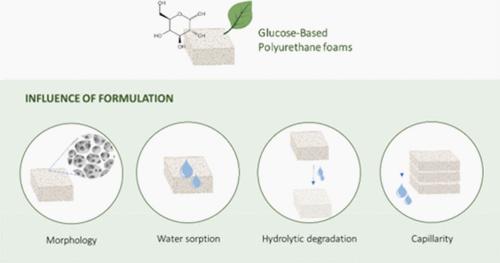Synthesis of Glucose-Based Polyurethane Foams and the Influence of Additives
IF 7.3
1区 化学
Q1 CHEMISTRY, MULTIDISCIPLINARY
引用次数: 0
Abstract
Polyurethane foams are usually prepared by reacting isocyanates and polyols and by adding any additives such as catalysts, surfactants, chain extenders, and blowing agents. Depending on the chemical nature of these components, the final properties of the materials can be tailored to meet specific requirements. In this paper, to reduce the use of petro-based polyols, d-(+)-glucose was used as a polyol in the preparation of sugar-based polyurethane foams to be applied in a bacteria detection device. Several formulations were tested, varying the amount of surfactant (B 8496), blowing agent (distilled water), the chain extender (1,4-butanediol), and isocyanate (toluene 2,4-diisocyanate), and the influence of formulation composition on morphology, density, hydrolytic degradation, water absorption, and capillarity was studied. Overall, it was possible to conclude that when increasing the amount of water and butanediol and decreasing the isocyanate ratio, the water sorption and capillarity tend to increase. Moreover, the amount of surfactant was the least influential factor in the material’s final characteristics. The formulation that showed better results (higher water absorption and capillarity and lower hydrolytic degradation) was formulation E with 20 μL of water, 200 μL of butanediol, 0.1 g of surfactant, and 1 mL of isocyanate. Although further compatibility testing is necessary, the absorption capacity, capillarity, and moderate degradation of the glucose-based PU foams demonstrate their potential suitability for future applications in functional materials, such as bacteria detection devices.

葡萄糖基聚氨酯泡沫的合成及添加剂的影响
聚氨酯泡沫通常是由异氰酸酯和多元醇反应,并加入任何添加剂,如催化剂、表面活性剂、扩链剂和发泡剂制备的。根据这些成分的化学性质,可以定制材料的最终性能以满足特定要求。为了减少石油基多元醇的使用,本文以d-(+)-葡萄糖为多元醇制备了用于细菌检测装置的糖基聚氨酯泡沫塑料。试验了几种配方,改变了表面活性剂(b8496)、发泡剂(蒸馏水)、扩链剂(1,4-丁二醇)和异氰酸酯(甲苯2,4-二异氰酸酯)的用量,研究了配方组成对形貌、密度、水解降解、吸水率和毛细性的影响。综上所述,随着水和丁二醇用量的增加,异氰酸酯配比的降低,吸水率和毛细性有增加的趋势。表面活性剂的用量对材料的最终性能影响最小。结果表明,吸水性和毛细性较好,水解降解率较低的E型配方为:水20 μL,丁二醇200 μL,表面活性剂0.1 g,异氰酸酯1 mL。虽然进一步的相容性测试是必要的,但葡萄糖基PU泡沫的吸收能力、毛细性和适度降解表明它们在功能材料(如细菌检测设备)中的潜在适用性。
本文章由计算机程序翻译,如有差异,请以英文原文为准。
求助全文
约1分钟内获得全文
求助全文
来源期刊

ACS Sustainable Chemistry & Engineering
CHEMISTRY, MULTIDISCIPLINARY-ENGINEERING, CHEMICAL
CiteScore
13.80
自引率
4.80%
发文量
1470
审稿时长
1.7 months
期刊介绍:
ACS Sustainable Chemistry & Engineering is a prestigious weekly peer-reviewed scientific journal published by the American Chemical Society. Dedicated to advancing the principles of green chemistry and green engineering, it covers a wide array of research topics including green chemistry, green engineering, biomass, alternative energy, and life cycle assessment.
The journal welcomes submissions in various formats, including Letters, Articles, Features, and Perspectives (Reviews), that address the challenges of sustainability in the chemical enterprise and contribute to the advancement of sustainable practices. Join us in shaping the future of sustainable chemistry and engineering.
 求助内容:
求助内容: 应助结果提醒方式:
应助结果提醒方式:


